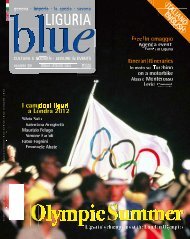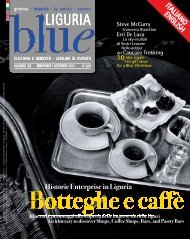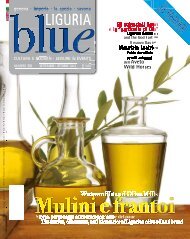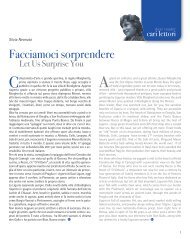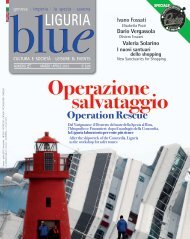Download PDF - Blue Liguria - Sagep
Download PDF - Blue Liguria - Sagep
Download PDF - Blue Liguria - Sagep
Create successful ePaper yourself
Turn your PDF publications into a flip-book with our unique Google optimized e-Paper software.
lue<br />
interview<br />
Monumenti, città<br />
e feste nazionali<br />
Monuments, Cities,<br />
and National Holidays<br />
Considerata una seconda festa<br />
nazionale degli Stati uniti da<br />
quando venne celebrato per la<br />
prima volta da italiani a San<br />
Francisco, nel 1869 (seguendo le<br />
celebrazioni italiane di New York),<br />
il Columbus Day fu festeggiato<br />
per la prima volta nella<br />
giovanissima America appena<br />
unita. Anni in cui, nel nome di<br />
Colombo, si battezzarono stati e<br />
decine di città e si inaugurarono<br />
centinaia di monumenti.<br />
Tra le statue di Cristoforo Colombo<br />
più famose, negli States, ci sono<br />
quella della Coit Memorial Towe di<br />
San Francisco (la foto a pagina<br />
103, nel reportage dedicato alla<br />
città californiana), quella del<br />
Columbus Circle di New York e<br />
quella della città di Columbus, in<br />
Ohio. E se in Europa, a Barcellona<br />
il monumento al grande<br />
navigatore domina la fine delle<br />
Ramblas e la bocca del porto (foto<br />
sotto), nella sua Genova si possono<br />
scoprire le statue di Principe e<br />
Castello D'Albertis e quella che<br />
viene considerata la sua casa<br />
natale, in vico Ponticello, nel cuore<br />
della città.<br />
Considered the second national<br />
holiday ever in the United States<br />
when it was proclaimed “coast to<br />
coast” by Italians from New York<br />
to San Francisco in 1869,<br />
Columbus Day had already been<br />
celebrated the first time by a<br />
brand new America just after the<br />
revolution. These were the years in<br />
which hundreds of monuments,<br />
dozens of cities, and even the<br />
District of Columbia and a river<br />
were baptized in Columbus’ name.<br />
Among the most famous statues<br />
of Christopher Columbus in the<br />
States, several stand out. There is<br />
the Coit Memorial Tower of San<br />
Francisco (photo on page 103), the<br />
one on Columbus Circle in New<br />
York, and then Columbus, Ohio’s<br />
Columbus statue honoring its<br />
namesake. And if in Europe,<br />
Barcelona has a monument to the<br />
great navigator that dominates<br />
the end of the Ramblas and the<br />
mouth of the port (photo below),<br />
in Columbus’ native Genoa you<br />
can find his statue in front of the<br />
train station in Principe, at the<br />
castle, Castello D'Albertis, and the<br />
house where he was born, on Vico<br />
Ponticello, in the heart of the city.<br />
“<br />
L’arte<br />
clan interessati all’apertura di nuove opportunità,<br />
protetto dai papi liguri regnanti a quel tempo, a<br />
quattordici anni Colombo viaggia nel Mediterraneo<br />
e nell’Atlantico. I Genovesi sono sulle coste<br />
oceaniche già all’inizio del Millecento. Nel 1277<br />
navigano per primi dal Mediterraneo alle Fiandre.<br />
Nel 1317 Manuele Pessagno fonda, con venti “sabedores<br />
de mar”, l’ammiragliato e la flotta portoghesi<br />
da cui scaturisce la prima espansione<br />
atlantica. L’“aristocrazia della vela”, che fornisce<br />
ammiragli a gran parte dell’Europa, ha lobby in<br />
tutte le Corti. I Genovesi frequentano da secoli la<br />
Penisola Iberica e Colombo è il simbolo dell’alleanza<br />
che, fin dal Mille, lega i principi e i mercanti<br />
italiani uniti in quella comune ricerca del beneficio<br />
che promuove un costante allargamento degli<br />
orizzonti. Infatti se tocca a lui aprire la nuova<br />
strada, che consente alla Spagna<br />
di conquistare una sua posizione<br />
nel mondo, sono comunque italiani<br />
i nomi di coloro che inaugurano<br />
l’“età delle scoperte” per<br />
conto delle altre Corone europee.<br />
Accanto a Colombo, Vespucci,<br />
Caboto, Verrazano sono<br />
icone di valenza mondiale.<br />
Ma la figura del primo Ammiraglio<br />
del Mar Oceano scompare<br />
subito dalla scena. Già gli Spagnoli<br />
lo mettono in catene e la<br />
sua damnatio memoriae accompagna<br />
spesso le ferocissime lotte<br />
tra l’Europa cattolica e quella<br />
protestante fino a quando, tra Sette e<br />
Ottocento, sono le colonie americane ribelli<br />
a recuperarne l’immagine di alfiere<br />
laico della libertà e di una nuova storia.<br />
I primi a celebrarlo nel 1769 sono gli italiani<br />
di San Francisco e nel 1792 a Baltimora<br />
gli viene eretto un monumento. Nel 1792 la<br />
giovane America esaltando, con il Columbus<br />
Day, la “scoperta” e il suo autore, protagonista<br />
dell’evento determinante da cui<br />
è nato il nuovo Occidente, celebra lo<br />
stacco dalla vecchia Europa, la sua predestinazione<br />
all’indipendenza e allo<br />
scontro con i poteri assoluti che hanno<br />
angariato chi ha scoperto il Nuovo<br />
Mondo; e altrettanto accade nell’ America<br />
latina di Simon Bolívar.<br />
Nel nome di Colombo si battezzano<br />
Stati, decine di città e si inaugurano<br />
centinaia di monumenti mentre lo United<br />
States Capitol ne illustra l’apoteosi.<br />
Nell’Ottocento, quando Genova è cen-<br />
di navigare<br />
induce chi la segue<br />
a desiderare di conoscere<br />
i segreti del mondo<br />
The art of navigation<br />
induces he who follows<br />
it, to desire to learn the<br />
secrets of the world<br />
is an immigrant. Tied to that great clan interested in<br />
the opening of new opportunities, protected by the<br />
<strong>Liguria</strong>n Popes reigning at the time, at age fourteen,<br />
Columbus is already sailing the Mediterranean and the<br />
Atlantic. The Genoese established themselves on the<br />
coasts of the Atlantic Ocean in the early 1100s. In 1277<br />
they were the first to sail from the Mediterranean to<br />
Flanders. In 1317 Manuele Pessagno founded – with<br />
twenty “sabedores de mar” – the Admiralty of the<br />
Portuguese Fleet, using which, he set off Portugal’s<br />
first expansion into the Atlantic. The “aristocracy of<br />
the sails” which supplied the admirals for most of<br />
Europe, had lobbies in all of the Courts. And the<br />
Genoese for centuries had contacts with the Iberian<br />
Peninsula, making Columbus the symbol of an alliance<br />
which, starting from the year One Thousand, tied<br />
princes and Italian merchants in the common search<br />
for profits, which was to promote a<br />
constant enlargement of their<br />
horizons. In fact, it was his turn now<br />
to open a new road. This allowed<br />
Spain to conquer its position in the<br />
world. But it must be acknowledged<br />
that the names of those who<br />
inaugurated the “Age of Discovery”<br />
for the other crowns of Europe are all<br />
Italian: along with Columbus, there is<br />
Amerigo Vespucci, Caboto (alias John<br />
Cabot), Verrazano, and other icons of<br />
world renown. But the figure of the<br />
first Admiral of the Ocean Seas soon<br />
disappears from the scene. The<br />
Spanish throw him in chains, and his<br />
damnatio memoriae accompany the often<br />
fierce battle between Catholic Europe and<br />
the protestant one, until – between the<br />
1700s and the 1800s – the American rebel<br />
colonies become the layman’s standard<br />
bearer for liberty. The first to celebrate<br />
Columbus in 1769 are the Italians of San<br />
Francisco, and in 1792 in Baltimore they erect<br />
a monument to him. In 1792, a young<br />
America celebrates, with Columbus Day, the<br />
discovery and its author, the leading player in<br />
a determining event from which the new<br />
West was born. It celebrates its detachment<br />
from Old Europe, its preordained<br />
independence, and its clash with the<br />
absolute and despotic powers who harassed<br />
the man who discovered the New World.<br />
And the same occurs in Latin America with<br />
Simon Bolívar. In the name of Columbus the<br />
States baptized dozens of cities and<br />
inaugurated hundreds of monuments.<br />
While at the United States Capitol he was<br />
”<br />
28



